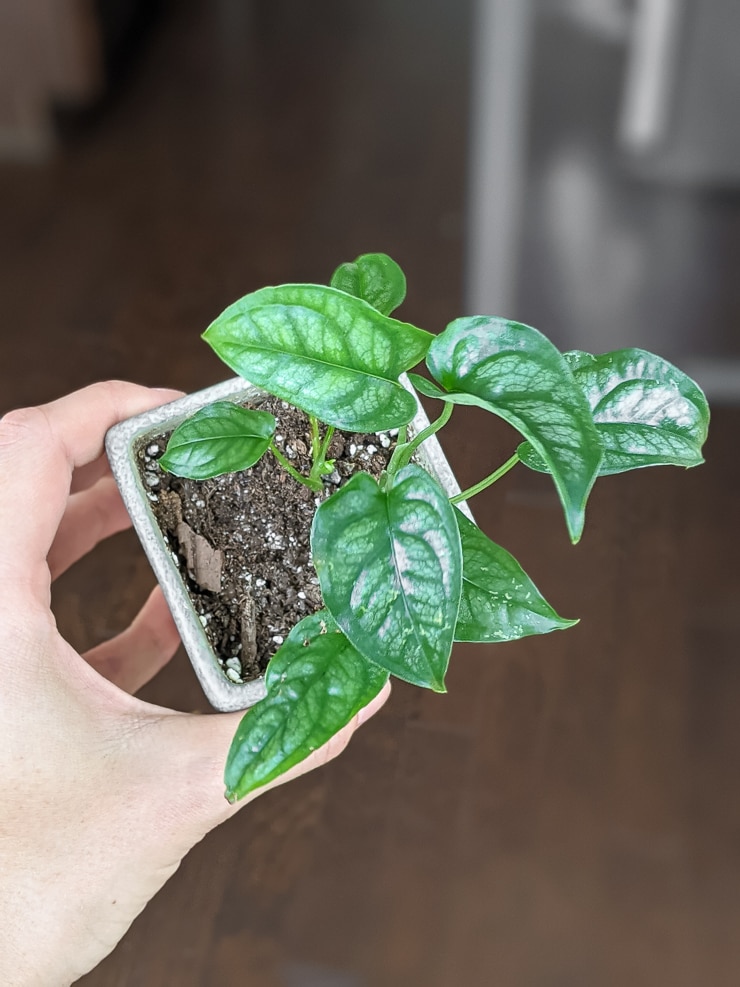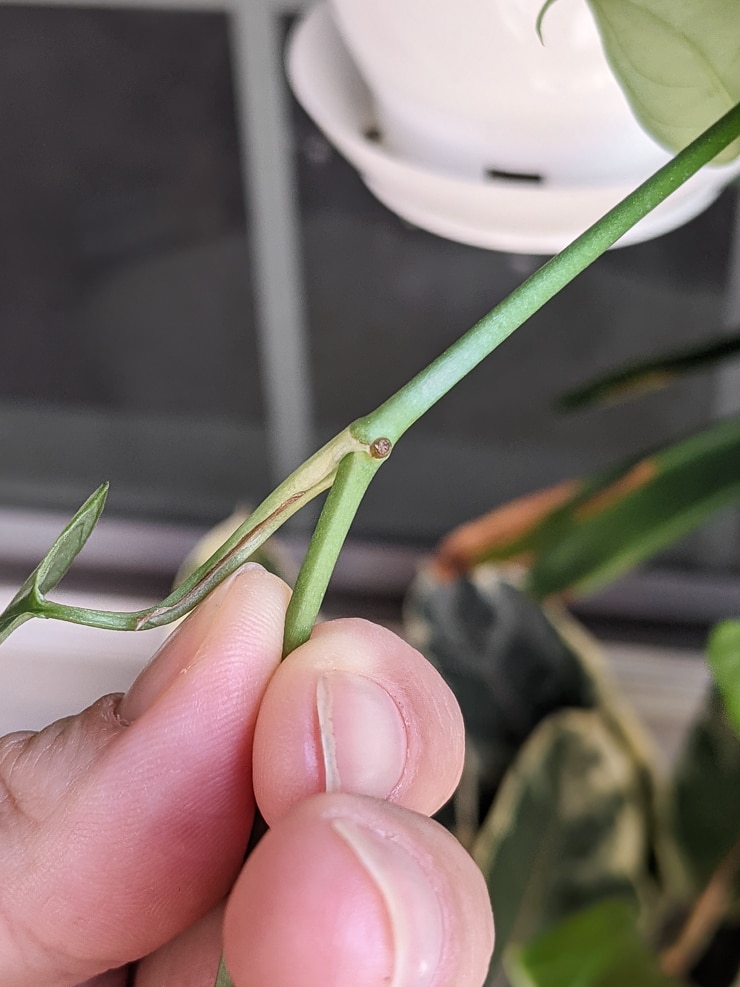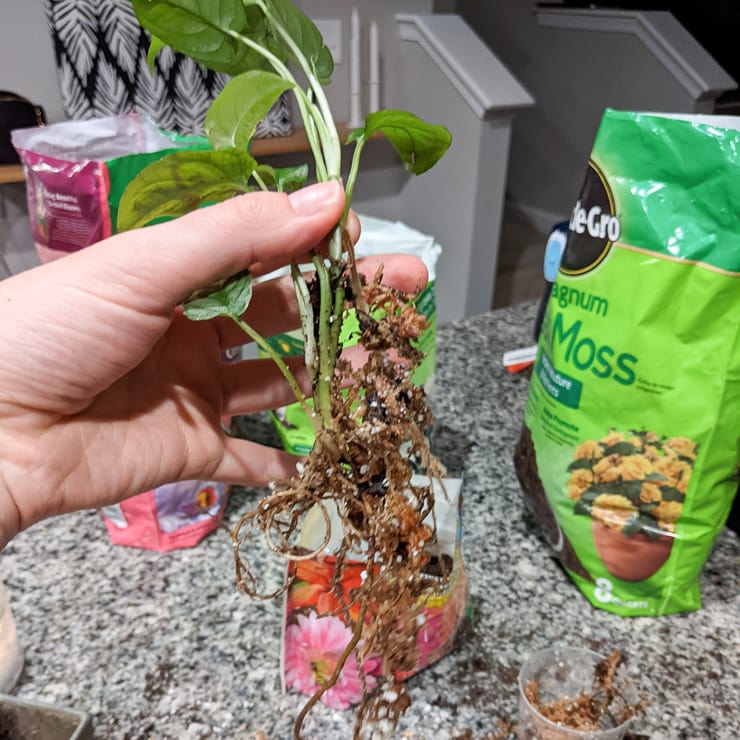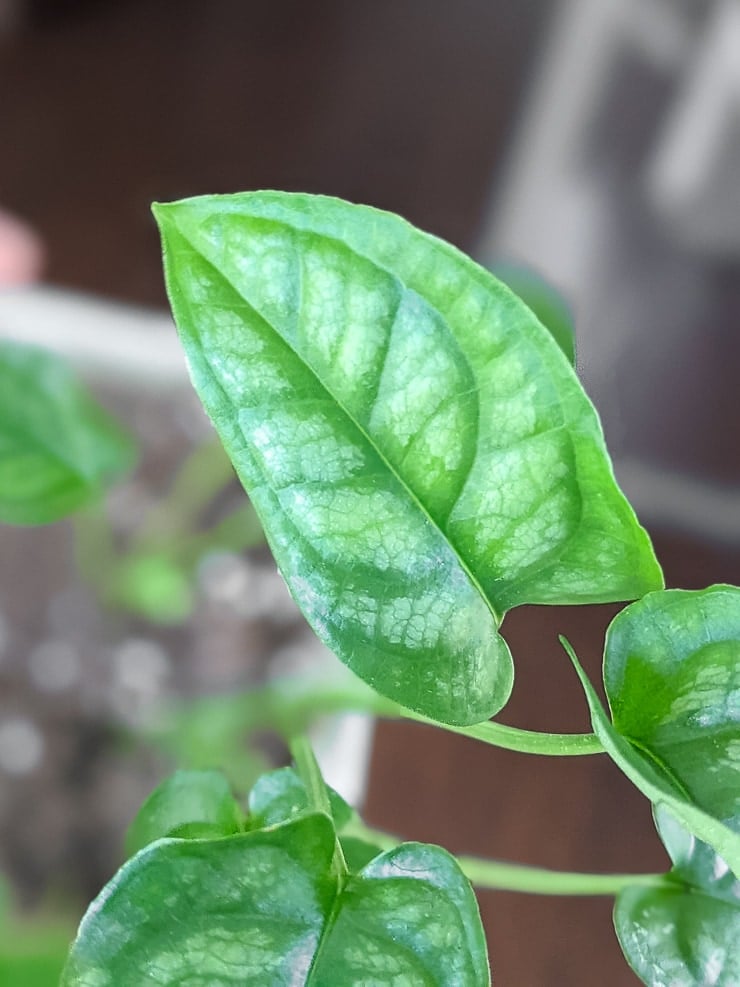Want to add a new monstera to your houseplant collection? Check out the monstera siltepecana! Monstera siltepecana care is pretty straightforward, and you’ll love having this gorgeous trailer as part of your collection.
All about monstera siltepecana care and propagation!
Alright gang, today we’re tackling a beautiful unique monstera siltepecana! This is a somewhat harder-to-find variety of monstera, but if you can get your hands on it, you definitely should. More on where to find them at the end of this post.
It’s a lovely climber and trailer that combines all of my favorite things about the monstera deliciosa (gorgeous foliage) and all of my favorite things about the monstera adansonii (lovely trailer/climber).
The monstera siltepecana is part of the monstera genus, which has over 50 lovely species. It’s not a philodendron—monsteras are commonly referred to as philodendrons, and it’s probably because they have a lot of similarities.
They are related, so that makes sense. “Philodendron” and “Monstera” are each a genus within the Araceae family. But the Araceae family has over 100 genera and thousands of species in it. So they aren’t super closely related.
If you’re looking around for a monstera siltepecana, you might see it referred to as a “silver monstera.” This is because you’ll likely find the juvenile version of this plant, and the juvenile version of this plant has a silver-gray sheen on its leaves. (More on juvenile vs. mature forms in a bit.)

How does the monstera siltepecana plant grow?
The monstera siltepecana leaves are a gorgeous light green with silver-gray markings on them. They really are gorgeous. The leaves are long and narrow and remind me a lot of cebu blue pothos leaves.
Much like the cebu blue pothos, the monstera siltepecana leaves also have two different forms: juvenile and mature. Juvenile leaves on both plants are smaller, longer, thinner, and do not have fenestrations (holes/splits).
The juvenile plants are also terrestrial growers, meaning they grow on the ground (aka dirt or soil). Once the plant matures, though, it becomes an epiphytic plant. Epiphytic plants grow up along other things for support, and while they have roots in dirt, they get nutrients from the air around them too.
The leaves also develop fenestrations and holes that are commonly associated with deliciosa and adansonii leaves. And they deepen in color and turn more green. I don’t know how long this takes, but I’ve read a few years.
And I don’t know if it’s even likely if you’re growing the plant as a houseplant. A lot of plants stay smaller and less mature as houseplants just because they aren’t in the most ideal conditions (like their natural habitat).

How to encourage your siltepecana to mature
If you want to encourage your siltepecana to mature, it absolutely needs something to grow up. This mimics its natural environment growing up trees! People commonly use moss poles for stuff like that. You can also use an actual branch 🙂
If you want to keep your siltepecana juvenile forever—which is totally vine—you can just keep it in a hanging basket or pot. I love how they trail, so that’s probably what I’ll be doing. The vines can grow several feet long.
How much light does a monstera siltepecana need?
Like many other monstera plants, the monstera siltepecana enjoys bright indirect light. It will tolerate slightly lower light levels, but the leaves will be smaller, and the plant might be a bit leggy. (That means there is more space between the leaves on the stem.)
To get a full, gorgeous plant, shoot for a full day or bright indirect light. If you take your plant outdoors for the spring and summer as I am doing this year, make sure it doesn’t get too much direct sun. This can burn the leaves.
A bit of direct morning sun is fine, but you should work your way up. For example, do an hour for a few days, then a few hours. Don’t let the plant get too much direct light, especially harsh afternoon sun. Once you burn the leaves, you can’t go back! Gotta cut them off.

What about water and soil?
Water when the top few inches of soil are dry. Don’t keep the plant too wet—it doesn’t like that and will likely develop root rot and die. Soil that stays too wet can also lead to fungus gnats indoors (learn about fungus gnats and how to get rid of them).
This generally means watering the plant about once a week during the spring and summer, but this really depends on temperature, humidity levels, and soil. I’ll be watering mine more outdoors in the summer since it will definitely dry out faster from the heat, even in well-draining soil.
And speaking of soil—soil is the key ingredient for keeping plants happy that like to be watered but don’t like to be watered too much. That’s because a good well-draining soil helps enhance drainage, helps get the soil moist without being sopping wet, and helps with aeration and air flow.
For your monstera siltepecana, choose any well-draining indoor potting soil. It comes with soil amendments in it like perlite and coco coir or fine moss. You can add in some additional coco coir as well, which I like to do. A bit of orchid bark won’t hurt either.


Monstera siltepecana care and yellowing
When I first got my siltepecana, it was from someone on Facebook who split off part of hers. It was a plant from a big box store, and big box stores aren’t always the best at caring for each plant’s unique needs. Therefore, it came to her with a bunch of yellow leaves.
Yellow leaves are often a sign of overwatering. The soil could also be too dense, retaining too much moisture. If the leaves are yellowing and browning, though, it’s probably underwatering.


Fertilizer needs
You can use a regular diluted houseplant fertilizer for the monstera siltepecana. However, you won’t need it if you have recently repotted your plant with high-quality potting soil. It already has goodies in it that will last about 6 months or so (the bag usually says).
However, you can be lazy like I am and not fertilize. I stopped fertilizing last year and decided to just incorporate worm castings into my repotting routine. They are super high in nutrients and good for plants. If a plant is already potted, you can just work some castings into the top level of soil with a fork.

Monstera siltepecana care: Temperature and humidity conditions
It’s always best to try to recreate a plant’s natural environment to keep it the happiest. The part of this I usually struggle with the most is humidity. Siltepecana plants love humidity levels, much like other monstera plants.
A few easy ways to add humidity for a plant are to use a humidifier, add a pebble tray by the plant and fill it with water, add some cups of water filled with LECA and water, and misting the plant. Or you can put it in a greenhouse cabinet like I have some of my humidity-loving plants.
The plant is patient, though, and it might be just fine without any humidity amendments. Just monitor it for signs of dryness (brown tips on the leaves, mostly). This plant likes temperatures above 50 degrees F, so it can be outside year round only in USDA zones 9, 10, and 11.
I’m not in those zones, so you have to keep it indoors when it gets too cold at night. However, since monstera plants love humidity, they love humid Maryland summers outside!

Monstera siltepecana propagation methods
You can easily propagate monstera siltepecana, and the process is pretty much the same as the steps to propagate monstera deliciosa and the steps to propagate monstera adansonii. Check those out if you’re interested, but here is an overview of how to propagate siltepecana!
Generally the best time to propagate any plant is in spring, summer, and early fall when the plant is out of its dormancy. You can propagate siltepecana using stem cuttings. Whatever method you use, take a cutting that has a node or two.
If you don’t see a little node on the stem, you can simply take a cutting and then remove the bottom leaf or two. Roots will grow from these areas—where the leaves meet the stem.

Propagating siltepecana in a sphagnum moss and perlite mixture
The easiest ways to do this in my opinion are in sphagnum moss/perlite, soil, or water. I propagated my cutting in a damp moss/perlite mixture, which is one of my favorite ways to root plants.
To root the cutting in a moss/perlite mix, I put the mix in a plastic cup, nestled the cutting down into the mixture, dampened it, and covered it with a clear plastic bag. The bag will help keep humidity levels high. But you could also use a clear propagation box.
Ensure you keep the moss mixture damp as you monitor root growth. Once it has some nice roots, you can transplant to soil. Check out my whole post on how to root plants in sphagnum moss for more details on this process!


Propagating siltepecana in water or soil
To propagate siltepecana in water or soil, you follow the same steps to take a cutting. If you’re using water, just put the cutting in a clear container with water. Monitor root growth over the next few weeks, and when they sprout roots that are an inch or two long, plant in soil.
Don’t be too worried if the plant drops and looks a little sad after you plant it. It is simply adjusting to soil since it has water roots. Keep the soil evenly moist for a few weeks, but not too wet. It should adapt!
You can also skip the water root step and plant the cutting directly in soil. If you do this, I recommend dipping it in rooting hormone first to help jump-start the root growth.
Keep the soil moist until you feel resistance when tugging on the cutting. Once you feel resistance, that means your plant has rooted. Yay. Resume care as normal to avoid overwatering.


Siltepecana pests to worry about
The siltepecana is vulnerable to all of the run-of-the-mill houseplant pests you can expect to encounter at some point as a houseplant hobbyist. Fungus gnats, spider mites, mealybugs, aphids, thrips, etc. But don’t panic! It’s a fact of houseplant hobbyist life.
Keeping your plants clean and isolating new plants that might bring in pests are the best ways to keep your plant healthy. If you encounter a pest issue, you can usually use a diluted neem oil spray to kill it off, a soapy water solution, or a simple store bought insecticide spray.

Is monstera siltepecana toxic to pets?
Sadly yes. Monstera plants in general are toxic when ingested, so it’s best to keep them away from cats, dogs, pets, and kids. Luckily they look great hanging up high out of reach, so that’s the perfect solution. See my post about 16 plants that are non-toxic to pets for more!

Where can I find a monstera siltepecana?
If you are lucky, you can find a big lush siltepecana in a hanging basket at a big box store. My friend found one at a Walmart, and it is gorgeous! They aren’t common, though. And someone will surely snatch them up as soon as they hit the shelves.
The best option is to try and find a cutting or plant locally. You will pay a bit more, but we can’t all be the lucky ones to find the big lush pots at the big box nurseries. I got mine from a Facebook group. I was originally buying another plant from her, but when she offered half of her siltepecana, I couldn’t turn it down!
My original siltepecana was from a trade I made on Facebook, too. When I got the bigger plant, I ended up selling my smaller original cutting that I’d rooted. Of course you can also try local nurseries, but I rarely see it where I live.
If all else fails, you can always order on Etsy (affiliate link). Make sure to shop around, review shipping policies, and review different prices and sizes. Also read the reviews for the shop you’re ordering from. See my post about my tips for buying plants on Etsy for more.

Pin my monstera siltepecana care tips!


Brittany is a seasoned DIY home and garden expert, running a creative brand since 2014 that inspires others with approachable plant care guides, woodworking tutorials, and decor projects. She is a certified project manager and has completed extensive coursework in the art and science of growing your own plants. Her work has been recognized by major publications, and she routinely collaborates with fellow DIY industry leaders—but her favorite thing to do is inspire you! Learn more about her here.

Leave a comment